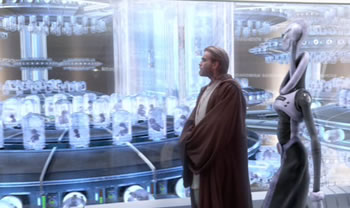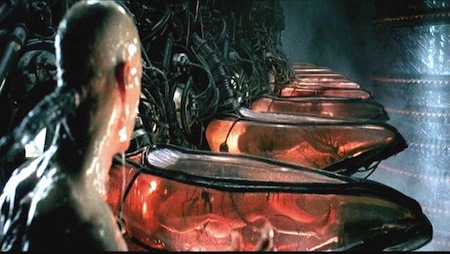Science Fiction
Dictionary
A B C D E F G H I J K L M N O P Q R S T U V W X Y Z
Mice Gestate In Mechanical Womb

For the first time, mouse embryos are grown outside the living womb of a mother mouse.
In a study published in the journal Nature, Dr. Jacob Hanna described removing embryos from the uteruses of mice at five days of gestation and growing them for six more days in artificial wombs.At that point, the embryos were about halfway through their development; full gestation is about 20 days. A human at this stage of development would be called a fetus. To date, Dr. Hanna and his colleagues have grown more than 1,000 embryos in this way.
(Via NYTimes.)
Science fiction fans of course recall the first description of a mechanical womb in Aldous Huxley's 1932 classic Brave New World:
...From the Social Predestination Room the escalators went rumbling down into the basement, and there, in the crimson darkness, stewing warm on their cushion of peritoneum and gorged with blood-surrogate and hormones, the foetuses grew and grew or, poisoned, languished into a stunted Epsilonhood. With a faint hum and rattle the moving racks crawled imperceptibly through the weeks and the recapitulated aeons to where, in the Decanting Room, the newly-unbottled babes uttered their first yell of horror and amazement.
(Read more about Huxley's artificial womb from Brave New World)
Fans of Frank Herbert remember the Axolotl Tanks from his 1969 novel Dune Messiah.
Also, compare the spinning vials from the artificial mouse womb to the vast artificial wombs in Star Wars Episode II:

(Obi Wan examines a clone factory line)
And of course in the 1999 film The Matrix.

(The Matrix farms Neo)
Thanks also to @DuneSF for posting this tweet:
Voila comment le Bene Tleilax a inventé les cuves Axolotl et commencé à cultiver des gholas. @DuneSF
— Elijaah Lebaron (@ElijaahL) March 18, 2021
Sauf que chez Frank Herbert les "cuves" étaient finalement plus "low tech". https://t.co/dhgYM7jucE
Scroll down for more stories in the same category. (Story submitted 3/7/2021)
Follow this kind of news @Technovelgy.| Email | RSS | Blog It | Stumble | del.icio.us | Digg | Reddit |
Would
you like to contribute a story tip?
It's easy:
Get the URL of the story, and the related sf author, and add
it here.
Comment/Join discussion ( 0 )
Related News Stories - (" Biology ")
Black Fungus Blocks Radiation
'You were surrounded by Astrophage most of the time' - Andy Weir, 2021.
Lunar Biorepository Proposed For Cryo-Preservation Of Earth Species
'...there was no one alive who had ever seen them. But they existed in the Life Bank.' - John Varley, 1977.
Let's Make Slaver Sunflowers! Engineering Plants To Reflect Light
'The mirror-blossom was a terrible weapon.' - Larry Niven, 1965.
Machete-Wielding Philodendron Isn't Going To Take It Anymore
'The tree ended its wild larruping, stood like a dreaming giant liable to wake into frenzy at any moment.' - Eric Frank Russell, 1943.
Technovelgy (that's tech-novel-gee!) is devoted to the creative science inventions and ideas of sf authors. Look for the Invention Category that interests you, the Glossary, the Invention Timeline, or see what's New.
Science Fiction
Timeline
1600-1899
1900-1939
1940's 1950's
1960's 1970's
1980's 1990's
2000's 2010's
Current News
The Zapata Air Scooter Would Be Great In A Science Fiction Story
'Betty's slapdash style.'
Thermostabilized Wet Meat Product (NASA Prototype)
There are no orbiting Michelin stars. Yet.
Could Crystal Batteries Generate Power For Centuries?
'Power could be compressed thus into an inch-square cube of what looked like blue-white ice'
India Ponders Always-On Smartphone Location Tracking
'It is necessary... for your own protection.'
Amazon Will Send You Heinlein's Knockdown Cabin
'It's so light that you can set it up in five minutes by yourself...'
Is It Time To Forbid Human Driving?
'Heavy penalties... were to be applied to any one found driving manually-controlled machines.'
Replace The Smartphone With A Connected Edge Node For AI Inference
'Buy a Little Dingbat... electropen, wrist watch, pocketphone, pocket radio, billfold ... all in one.'
Artificial Skin For Robots Is Coming Right Along
'... an elastic, tinted material that had all the feel and appearance of human flesh and epidermis.'
Robot Guard Dog On Duty
I might also be thinking of K-9 from Doctor Who.
Wearable Artificial Fabric Muscles
'It is remarkable that the long leverages of their machines are in most cases actuated by a sort of sham musculature...'
BrainBridge Concept Transplant Of Human Head Proposed
'Briquet’s head seemed to think that to find and attach a new body to her head was as easy as to fit and sew a new dress.'
Google's Nano Banana Pro Presents Handwritten Math Solutions
'...copy was turned out in a charming and entirely feminine handwriting.'
Edible Meat-Like Fungus Like Barbara Hambly's Slunch?
'It was almost unheard of for slunch to spread that fast...'
Sunday Robotics 'Memo' Bot Has Unique Training Glove
'He then started hand movements of definite pattern...'
Woman Marries Computer, Vonnegut's Dream Comes True
'Men are made of protoplasm... Lasts forever.'
Natural Gait With Prosthetic Connected To Nervous System
'The leg was to function, in a way, as a servo-mechanism operated by Larry’s brain...'
